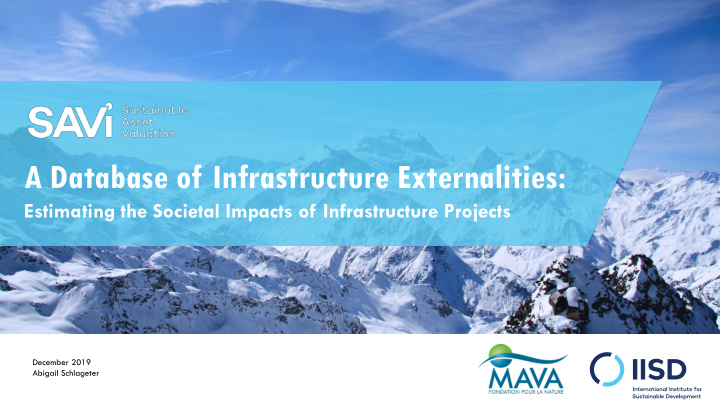



A Database of Infrastructure Externalities: Estimating the Societal Impacts of Infrastructure Projects December 2019 Abigail Schlageter
IISD has developed a database that compiles available knowledge on the valuation of What? infrastructure project externalities, direct costs and climate risks.
Designed to support the estimation of financial performance of infrastructure assets. It includes the value of externalities and Why? climate risks that are typically unaccounted for in conventional project assessments. It also provides some direct costs of infrastructure.
Data Collection Literature Review Data pulled from relevant peer- reviewed journals and case studies How? Public Data Data provided by governments, NGOs or businesses
The database can be used to estimate costs related to transport, energy, Infrastructure Types water management, material management, building, mining, or nature-based infrastructures
Externalities Environmental (1,059 rows) Social (291 rows) Governance (4 rows) What values does the Direct Costs (196 rows) database include ? Costs of implementation Costs related to operation and management Climate Risk (511 rows) Effects of climatic changes on infrastructure Linkage to relevant Copernicus datasets
Environmental Air pollution, climate change impacts, ecosystem services, environmental remediation, water discharge and pollution, and water use and withdrawal Social Externalities Child labour, community development, customer included satisfaction, changes in marketability, health and safety, labor demand, labor opportunity costs, and property value changes Governance Bribery and corruption, and vision and monitoring
Costs Related to Implementing Infrastructure Cost per unit of material Direct costs Construction costs included Maintenance costs $ Land use costs etc. $ $
Impacts of Climate Change on Infrastructure Changes in energy demand Climate risks Changes in efficiency/ capacity of infrastructure included Changes in durability/ performance of infrastructure Costs related to adapting/ failing to adapt to climate change
Ability to Filter By: How does the Infrastructure type database Externality type function? Stage of the project life in -/+ which the cost is incurred $$
Database Structure: Column A: Identifies externality being evaluated Column B: Provides supplementary information on externality Column C: Identifies the parameter Column D: Identifies the unit and currency Column E: identifies the corresponding value of the externality
Column F: Information about the source, the value and how the value was obtained Columns G and H: Linked sources Column I: Region (if value or case study are region-specific)
Columns J-P: Indicate which infrastructure type is impacted
Columns Q-S: Indicate in which part of the infrastructure project’s life the cost is incurred: Construction Operation and management Decommissioning
Within Climate Risk Tab: Column Q: Emissions scenario corresponding to value Column R: Identifies if the value can be linked to a Copernicus dataset Column S-U: The title of the relevant Copernicus dataset, the values that correspond and the units associated with these values.
Example of Database’s Application Scenario: Comparing Wind Energy and Coal-Powered Energy Sources (i) Select tab related to externality type: e.g. Environmental (ii) Filter by infrastructure type (Columns J-P): e.g. energy infrastructure
(iii) Filter by externality type that is of interest (Column A): e.g. air pollution -/+ $$
(iv) Filter further by parameter to obtain relevant values (Column C): e.g. p arameters relevant to wind and coal power generation
The database yields relevant information from two sources: Health impacts from particle emissions based on population density Cost due to carbon emissions over the lifecycle of each plant (based on carbon tax value)
Similarly, filtering in climate risk tab with respect to wind generation and coal generation yields information on plant performance changes due to climatic changes: The relevant Copernicus dataset is identified in Column S (corresponding values and units in Columns T and U)
Similar strategies can be employed for other externality types, direct costs or infrastructure project types Examples of social externalities and direct costs:
Thank You!
Recommend
More recommend